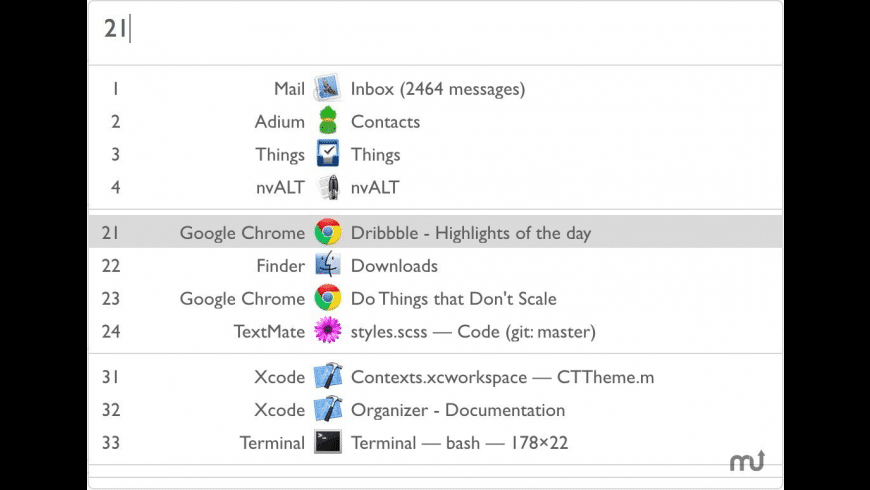- Contexts 3 4 1 – Fast Window Switcher Systems Installation
- Contexts 3 4 1 – Fast Window Switcher Systems Inc
- Contexts 3 4 1 – Fast Window Switcher Systems Inc
- Contexts 3 4 1 – Fast Window Switcher Systems System
Figure 3.4 - Diagram showing CPU switch from process to process. Unnumbered side bar. Digging Deeper: The Linux taskstruct definition in sched.h ( See also the top of that file. ) 3.1.4 Threads. Modern systems allow a single process to have multiple threads of execution, which execute concurrently. Threads are covered extensively in the next. How to Display and Hide the Windows 10 Desktop. Use the Win+D shortcut to display and hide the desktop. This command forces Windows to switch to the desktop immediately and minimize all open windows to the taskbar. Use the same shortcut to bring back those open windows. Audio Switch 2.0 main menu. Nicole Cozma/CNET To switch Playback devices, left-click the Audio Switch icon in the system tray and select it from the list.
Leveraging System Context in Windows
I'd like to take things away from App-V for this blog if possible. Give the site a little more variety. I have been working with App-v mainly, however, I have also obviously been involved with MSI packaging and OS migration. With Windows 7, some features have been deprecated and as an IT professional, learning the little nuances in the new platform is part of the challenge and fun!
One of the first walls I ran into, with Windows 7, was met when I was working on a project that required me to perform my test install in system context. The reason why I wanted to do this was to mimic the install in the context it would be deployed in. Previously, when testing on XP, I would have used the ‘At interactive' method to do this, but this is no more. A colleague of mine actually told me about this nice little tool for launching the command window in System context on Win7. I shall dispense this advice now(Crappy Sunscreen song reference, sorry)
How To Test an application install in the system context mode to mimic Deployment tools
You can open up an entry point in System context by following the below four steps.
Step 1: Run Command Window as Administrator
Step 2: Use psexec.exe
You will need to use the SysInternals Tool ‘psexec.exe'. These tools are a free set of troubleshooting and development tools that can be found on the Microsoft Technet site at the following location: – https://technet.microsoft.com/en-us/sysinternals/default.aspx The Sysinternals tools get updated so you should ensure you have the latest set.
Run the command as seen below (NOTE: Location of your psexec.exe may differ in this case I have copied the psexec.exe to the desktop as illustrated below):
Contexts 3 4 1 – Fast Window Switcher Systems Installation
A new CMD window should appear:
Step 3: Verify Context
Close the original cmd window as seen in Figure 2 and check Task Manager (Task Manager can be launched by right-clicking the taskbar and choosing Task Manager)(Explain how you launch task manager) to ensure your command window is now running in System context: Edgeview 2 1 980.

Step 4: Perform Actions
Contexts 3 4 1 – Fast Window Switcher Systems Inc
Run your install or do whatever it is that you aim to do in the System Context. This should help you to mimic the customer's deployment method by installing in the correct context.
Contexts 3 4 1 – Fast Window Switcher Systems Inc
Get the App-V Decison Matrix and Interactive Tool.
Contexts 3 4 1 – Fast Window Switcher Systems System
In addition to the new APIs, check out these updates to the app model, MSIX and WSL.
Windows Subsystem for Linux: The Windows Subsystem for Linux 2 is the latest and greatest version of WSL. It has significantly faster file IO performance (up to 20x faster) with full system call compatibility, meaning you can run more of the Linux apps you love (like Docker).
Hosted App Model: Applications can now declare themselves as a host for other applications via the new HostRuntime extension. These hosted apps look and behave like independent apps and can have deep Windows integration, even though they get their main executable from the host app. This technology powers PWAs on Microsoft Edge. To get started using the Hosted App Model, see this blog.
Sparse Signed Packages: Applications can now include a signed MSIX package in their existing installers and have their installers register it. This allows applications to keep their existing installers but still assign themselves identities. An identity makes the app known to Windows and allows for a more deeply integrated experience by enabling the app to call Windows APIs that require identities such as Tiles, Toasts, Notifications and BackgroundTasks.
IMPROVED DISK USAGE FOR WINDOWS SEARCH
In 19H1, Microsoft asked Insiders why they were turning off the search indexer. Your feedback helped Microsoft make improvements then and helped focus on three key areas of improvement in Windows 10 version 2004: excessive disk and CPU usage, general performance issues, and low perceived value of the indexer.
Based on this, Microsoft is introducing an algorithm that detects high disk usage and activity, so it can better identify peak usage times and manage the indexer accordingly. Microsoft is also making changes for developers to prevent searches of certain repositories and project folders to improve disk usage.
QUICK SEARCHES NOW IN SEARCH HOME
To help you find the info that matters even faster, Microsoft has added four quick web searches to your Search Home:
Weather: Get current conditions and the upcoming forecast
Top news: Read the latest headlines from popular news sites
Today in history: Explore four events that happened on this day
New movies: Find out what's playing in theaters near you
